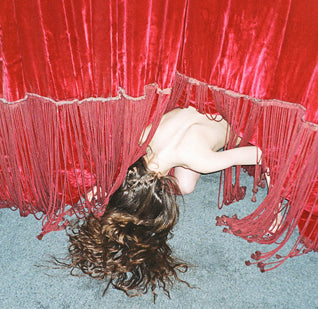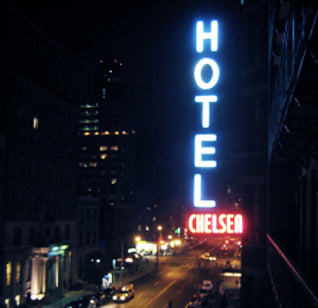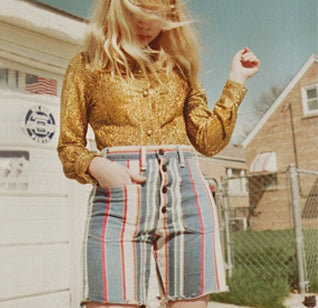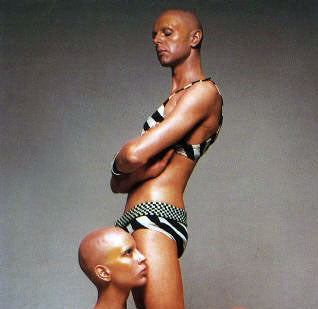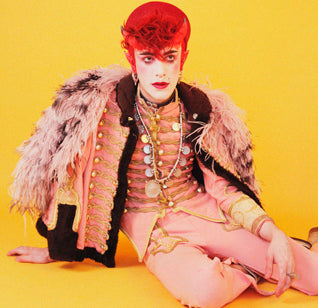BODY POLICE
The misogyny of social media censorship
by Jade French
Censorship. The word conjures up the cultural contraband. It’s not necessarily the first word you would associate with social media platforms like Instagram, but after a series of backlashes against users’ content, the censorship of personal images online is rising.
Instagram say they are trying to create "the safest possible place for teens and adults" with their terms of use stating: "You may not post violent, nude, partially nude… pornographic or sexually suggestive photos”. Taking their crusade as far as monitoring hashtags to control user content.

Banned from Instagram, March 2014: Richard Prince, 'Spiritual America', 1983
However, scanning through a list of hashtags that are banned suggests a force darker than moderating non-pornographic content is at play. Whilst censoring words that engage with the culture of overtly misogynist and sexual language, such as #fuckbitches and #deepthroat, makes sense policing #breasts is an attack on anatomy and a form of body policing.
By allowing users to flag content, Instagram claim to democratize censorship, hiding behind a mass mentality that is very much influenced by the media it consumes. This means the press ingrained discomfort of viewing bodies outside the socialized norm has led to some content being flagged more than others. Such as, Petra Collins picture of her pubic hair, where she was fully covered with only natural tufts peeking out from her clothing was flagged up due to the supposedly inappropriate nature of female body hair. And Meghan Tonjes’ fully covered butt selfie, a tag so common it has it’s morphed into a #belfie, which was targeted because she was a real woman, not a photoshopped size 0.

Banned from Instagram, October 2013: Petra Collins, 'Bikini', 2013
However, most frequently, body censorship online is focused on breasts. What’s the difference between #underboobs and #boobs? Well, the former has been allowed through Instagram’s censorship and the latter has not. When we begin to draw lines in the sand over which type of women are allowed to portray their sexuality and bodies, and the angle by which they choose to do so, online social conventionality begins to police women. Enforcing the ironies of 21st century womanhood: don’t be a slut, but don’t be frigid, you can show your underboob, but nipples are too sexual.
Perhaps it boils down to semantics. Would a male nipple cause this much controversy? Or even be deemed as partial nakedness? Probably not, especially when #manboob is fully ok to check out. It begs the question who are these rules aimed at?

Free the Nipple campaign image, 2013
In banning images, Instagram isn’t necessarily protecting its audience – rather asking them to seek out the not-suitable-for-work version Pornstagram, where the images of people, mainly women, uploaded would fry the Instagram filters and where “social porn” is gaining traction.
The recent, “Free The Nipple” campaign is centred around female empowerment and questioning the most ridiculous basis of gender inequality online. That a woman baring her breasts is a newsworthy item would be ludicrous, if it wasn’t so necessary to highlight the existing incompatibilities with how we treat male and female body image. This high-profile movement seeks not to shock, but to normalize. Lina Esco documented the movement in her comedy film following the true story of the campaign to decriminalized nakedness in the streets of New York City. On its release, it was given a rating of NC+17, regarded as pornography, despite having no sex scenes.
In June, Scout Willis used her nudity and NYC’s redefined laws to walk through the East Village topless in order to highlight the campaign. As of the publication of this article #freethenipple is a fully searchable term on Instagram – and unsurprisingly reveals a lot.

Banned from Instagram, November 2012: Jean-Luc Godard, 'Save Yourself'
Just as you may imagine, the work of censorship shows off the very thing it was trying to ban. The campaign and film go beyond the Valencia filtered world of Instagram to ask questions about the consumption of media in regards to the female body. As Twilight actress and Free the Nipple activist Casey LaBow puts it, parents would “…rather their kids see a terribly violent film than see a female areola”.
By banning images deemed unsuitable, social media platforms, such as Instagram, begin to blur the lines between body shaming and “community standards”. These banned pictures, be they of pubic hair, butts or boobs become symbols for a collective fear of female bodies that deviate from the “norm”. Ironically #slutshame, the very thing Instagram’s body policing does, is searchable too – allowing us to delve even deeper into the repression of female bodies.
See the images social media websites have censored, here.












